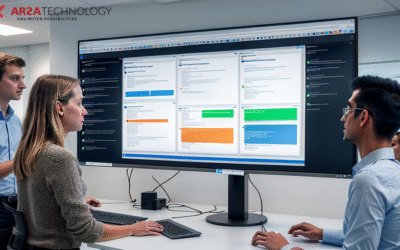Introduction: Overcoming Scalability Challenges in the Broadcasting Industry
In the dynamic world of broadcasting, delivering accessible and engaging content is paramount. Automated subtitle and closed caption generation has become an indispensable component, not just for regulatory compliance but also for expanding audience reach, enhancing viewer experience, and improving content discoverability. However, the sheer volume and real-time demands of broadcasting—from live news feeds and sports events to extensive video-on-demand (VOD) libraries—present significant scalability challenges for developers integrating Speech-to-Text (STT) APIs.
Traditional transcription methods or inefficient API integrations can quickly become bottlenecks, leading to delayed content, increased operational costs, and missed opportunities. At ARSA Technology, we understand these pressures. This guide is designed for software developers, solutions architects, CTOs, and product managers in the broadcasting sector who are navigating the complexities of integrating and debugging STT APIs at scale. We will explore common pitfalls, strategic debugging approaches, and best practices to ensure your automated captioning solutions are not just functional, but robustly scalable and cost-effective.
Understanding the Scalability Imperative for Broadcasting
The broadcasting industry operates under unique pressures that amplify the need for highly scalable STT solutions. Consider the instantaneous demand of a breaking news event requiring live captions, or the continuous processing of thousands of hours of archival footage for VOD platforms. Any delay or failure in transcription directly impacts content delivery, audience engagement, and ultimately, revenue.
Poor scalability manifests in several critical ways:
* Delayed Content Release: Slow transcription processes can mean content misses critical viewership windows, especially for time-sensitive news or sports highlights.
* Increased Operational Costs: Manual intervention to correct errors or expedite delayed captions drives up labor costs. Inefficient API usage can also lead to unexpected infrastructure expenses.
* Audience Dissatisfaction: Inaccurate or missing captions detract from the viewer experience, potentially alienating segments of the audience and impacting brand loyalty.
* Compliance Risks: Failure to provide timely and accurate captions can lead to regulatory penalties in many jurisdictions.
ARSA Technology’s Speech-to-Text API is engineered to address these foundational needs, providing a high-performance solution capable of handling the demanding workloads of modern broadcasting. Our focus is on empowering your teams to deliver content efficiently and reliably, without compromising on quality or speed.
Common Bottlenecks in Speech-to-Text API Integrations for High-Volume Workloads
Even with a powerful API, integration challenges can impede scalability. Identifying these bottlenecks early is crucial for maintaining efficient operations. Without diving into specific code, we can understand the strategic implications of these common issues:
- Inefficient Data Handling: How audio data is prepared and transmitted can significantly impact performance. Large, unoptimized audio files or fragmented data streams can overwhelm network resources and API processing queues.
- Suboptimal API Interaction Patterns: Relying on basic “send and wait” requests without considering asynchronous processing for longer audio, or failing to implement robust retry mechanisms, can lead to timeouts and processing failures under heavy load.
- Lack of Resource Management: Without proper internal queueing or parallel processing strategies, your application might struggle to manage multiple concurrent transcription requests, leading to system overload and degraded performance.
- Inadequate Error Handling and Monitoring: When errors occur, a lack of clear logging or automated retry logic means failures go unnoticed or require manual intervention, disrupting the automated workflow and making debugging difficult.
- Network Latency and Throughput: The physical distance between your servers and the API’s data centers, or insufficient network bandwidth, can introduce delays that accumulate rapidly at scale, impacting real-time applications.
Addressing these strategic areas is key to unlocking the full potential of your STT API integration and ensuring it can meet the rigorous demands of the broadcasting environment.
Strategic Debugging: Proactive Measures for Scalable Subtitle Generation
Effective debugging for scalability goes beyond fixing individual errors; it involves designing your integration for resilience and efficiency from the outset.
Optimizing Data Ingestion for Peak Performance
The way you prepare and send audio to the API is foundational to scalability. For large audio files, consider strategies like chunking the audio into smaller segments for processing, which can reduce memory footprint and allow for more parallel processing. For live streams, ensure your audio capture and streaming mechanisms are robust and deliver data in a consistent, optimized format. Minimizing payload size through efficient compression (without compromising audio quality) can significantly improve transmission speeds and reduce processing times.
Designing Resilient API Interaction Patterns
Your application’s interaction with the STT API must be designed for high availability and fault tolerance. Implement robust retry mechanisms with exponential backoff to gracefully handle transient network issues or temporary API rate limits. For longer audio files, leverage asynchronous processing capabilities where your application submits a request and polls for results later, freeing up resources for other tasks. This prevents your application from blocking while waiting for a single, lengthy transcription to complete. To see the API in action, demo the Speech-to-Text API and explore its capabilities.
Monitoring and Analytics: The Cornerstone of Proactive Scalability Management
You cannot optimize what you don’t measure. Implement comprehensive monitoring for your API integration. Track key metrics such as:
* API Request Volume: Understand peak usage times and overall demand.
* Response Times: Identify any latency spikes that could indicate bottlenecks.
* Error Rates: Quickly detect and address issues that lead to failed transcriptions.
* Queue Lengths: If you’re using internal queues, monitor their size to ensure requests are processed efficiently.
This data provides invaluable insights, allowing you to proactively identify potential scalability issues before they impact your broadcast operations.
Leveraging ARSA Technology’s Robust Infrastructure
ARSA Technology’s Speech-to-Text API is built on a high-performance, globally distributed infrastructure designed to handle enterprise-level workloads. Our backend is optimized for high throughput and low latency, ensuring that your requests are processed quickly and reliably, even during peak demand. By integrating with ARSA, you’re leveraging a system engineered for the very scalability challenges you face, allowing your teams to focus on core broadcasting innovations rather than infrastructure management.
Troubleshooting Specific Scalability Hurdles in Live and On-Demand Broadcasting
The demands of live versus on-demand content present distinct scalability challenges.
Addressing Latency in Live Captioning
For live broadcasts, minimizing latency is critical. Strategies include:
* Real-time Audio Chunking: Processing audio in small, continuous chunks allows for near-instantaneous transcription, crucial for live events.
* Optimized Network Paths: Ensuring your application has the most direct and efficient network connection to the API’s servers can shave off valuable milliseconds.
* Prioritization: Implementing internal logic to prioritize live stream transcription over less time-sensitive tasks during peak loads.
Every millisecond saved contributes to a more seamless and compliant live viewing experience.
Managing High-Volume Backlogs for VOD Libraries
For extensive VOD libraries, the challenge shifts from real-time speed to efficient batch processing of vast amounts of data.
* Parallel Processing: Design your system to submit and manage multiple transcription requests concurrently, maximizing throughput.
* Queueing Systems: Utilize robust message queues (e.g., Kafka, RabbitMQ) to manage transcription jobs, ensuring that even if the API or your system experiences temporary slowdowns, no data is lost and processing resumes automatically.
* Cost Optimization: Strategically schedule large batch jobs during off-peak hours to potentially leverage different pricing tiers or optimize resource allocation.
Ensuring Accuracy Across Diverse Audio Inputs
While not strictly a scalability issue, transcription accuracy directly impacts the efficiency of your workflow. Poor accuracy necessitates manual review and correction, which becomes a significant scalability bottleneck for high volumes of content. ARSA Technology’s commitment to delivering our highly accurate transcription API means less post-processing, faster content readiness, and ultimately, a more scalable and cost-effective solution for your broadcasting needs. Our advanced models are trained on diverse datasets to handle various accents, speaking styles, and audio qualities common in broadcasting.
Beyond Transcription: Enhancing the Broadcasting Workflow with ARSA’s AI Portfolio
While Speech-to-Text is a cornerstone for automated captioning, ARSA Technology offers a broader suite of AI APIs that can further enhance your broadcasting operations. For instance, after generating captions, you might need to create voiceovers for different language markets or generate natural voice responses for interactive content. Our Text-to-Speech API allows you to generate natural voice responses with our TTS API, providing a seamless solution for multilingual content creation or accessibility features, further streamlining your content production pipeline. Integrating these complementary services can lead to a more comprehensive and efficient AI-powered broadcasting solution.
Conclusion: Your Next Step Towards a Solution
Scalability is not merely a technical feature; it’s a strategic imperative for the broadcasting industry. Overcoming the challenges of high-volume subtitle and closed caption generation requires a robust API, intelligent integration design, and proactive debugging strategies. ARSA Technology’s Speech-to-Text API provides the foundation for a highly scalable, accurate, and efficient transcription solution. By focusing on optimized data handling, resilient API interaction patterns, and comprehensive monitoring, your development teams can build systems that not only meet today’s demands but are also prepared for the future growth of your content.
Ready to Solve Your Challenges with AI?
Discover how ARSA Technology can help you overcome your toughest business challenges. Get in touch with our team for a personalized demo and a free API trial.







